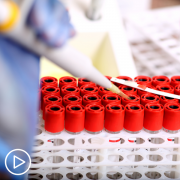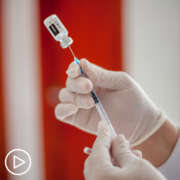How Does Myeloma Testing Affect Care and Treatment?
How Does Myeloma Testing Affect Care and Treatment? from Patient Empowerment Network on Vimeo.
What is cytogenetic testing in myeloma? Donna Catamero, a nurse practitioner specializing in myeloma, describes this in-depth testing, including the FISH test, and how the results impact the care of patients.
Donna Catamero is Associate Director of Myeloma Translational Research at Icahn School of Medicine at Mount Sinai Hospital in New York City.
Related Programs:

|

Myeloma Test Results and Factors That Impact Treatment Decisions |

What Key Questions Should Myeloma Patients Ask About Treatment? |
Transcript:
Katherine:
Blood and urine tests, bone marrow biopsy and imaging tests are all standard following a myeloma diagnosis, but what about more in-depth testing?
Because the terminology around biomarker testing varies, can you help break this down for patients, and how this in-depth testing is referred to in myeloma?
Donna:
So, biomarkers is a term that is commonly tossed around in many different cancer diagnoses and it means different things. But in general, it’s characteristics that can inform us about a diagnosis, about a patient’s prognosis and about their response to treatment. So, this can include things that we measure in the bloodwork, in the urine, even imaging. These are all things or markers that we look at to determine a patient’s either, like I said, response or risk stratification.
Katherine:
What about cytogenetics? What is that exactly and does that fit under the umbrella of biomarker testing?
Donna:
Yeah, so cytogenetics is a genetic snapshot of a patient’s cancer. So, it will give us a sense of how the disease will – the characteristics of how it will behave. But again, it’s just a snapshot and it’s not a precise science but certain mutations or certain genes will kind of inform us like “This might be maybe a more aggressive form and we need to do X, Y and Z.”
Katherine:
Which of these more in-depth tests are necessary in myeloma? Let’s start with the FISH test.
Donna:
So, FISH is a cytogenetic technique. So, what we do is, when we do the bone marrow, we send that off and we look at the genetics. Like I said, it’s a snapshot. And certain mutations will put patients in different risk stratifications, so we normally do this at the time of diagnosis and then with each relapse.
Katherine:
It seems that all of the test results can aid in determining outpatient’s risk. So, why is risk stratification so important?
Donna:
So, risk stratification is important.
It will give us a sense of how a patient might respond to certain treatments. Maybe a patient won’t respond as well to a stem cell transplant as someone with standard risk. So, we take this into account, but in this current time, in 2021, we don’t typically change our treatments according to risk. That’s why clinical research is very important because we’re studying right now patients with high-risk cytogenetics, do they do they better on certain therapies.
Katherine:
How do the results of these tests affect treatment choice and prognosis?
Donna:
So, someone who might have high-risk cytogenetics, we might want to be maybe more aggressive with our therapy. So, we might change how we want to maintain a patient. Usually, after a stem cell transplant, we give patients maintenance therapies. So, patients who have high-risk disease, we might change our strategy and have a more aggressive regimen in that maintenance setting. And with patients with higher risk, we probably will monitor them very, very closely in case – looking for signs for relapse.










